Light switch with dimmer: device, selection criteria and manufacturers review
Over time, household appliances undergo changes, becoming safer and more comfortable to use. More recently, dimmers, devices that change the power of lamps, have come into wide use.
A light switch with a dimmer is a special convenience in use - a device that practically does not differ externally from a conventional device.
Let's look at the design features of devices with a regulator, their advantages and disadvantages, as well as connection options.
The content of the article:
Dimmer switch design
Dimmer is a special device, the purpose of which is to gradually regulate the level of artificial lighting. Via dimmer switch you can transform the room by creating a twilight or a gulf of light in it.
The first device to have a mechanical operating principle was patented in the United States in the 1890s. It was used to gradually darken the theater hall.
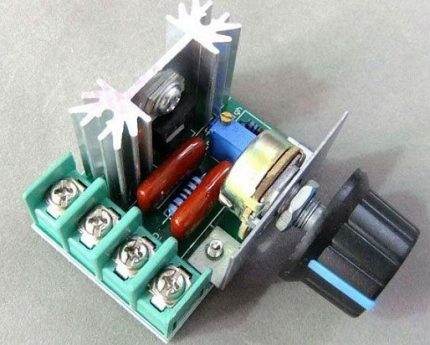
The set of options for modern devices is much wider. They can be programmed to turn off automatically by setting a timer, or set to simulate the presence effect. This involves turning on / off, as well as changing the brightness of the light for a certain time, for example, a day according to a given mode.
Distribution also received instrument options that allow remote or voice control. All these dimmers fit perfectly into the “smart home” system and play an important role in it.
Models of dimmer switches
The profile market offers a wide range of models that can be classified based on various criteria:
- working principle;
- design features;
- adjusting equipment;
- compatibility with lamps of different types.
Consider the listed classifications in more detail.
Thermostat and triac dimmers
By the principle of operation, all equipment can be divided into two fundamentally different large groups.
Dimmers based on rheostat
Initially, dimmers were manufactured using a set of resistors. By changing the resistance with the lever, it was possible to adjust the lighting. When this indicator increased, the current decreased, and the light in the lamp became weaker. Conversely, by reducing the resistance, it was possible to enhance the luminous flux.
Such devices have a fairly simple device, however, from different manufacturers, dimmers differ due to the build quality and components used. Such variability affects the stability of the work (especially at low voltage) and smoothness.
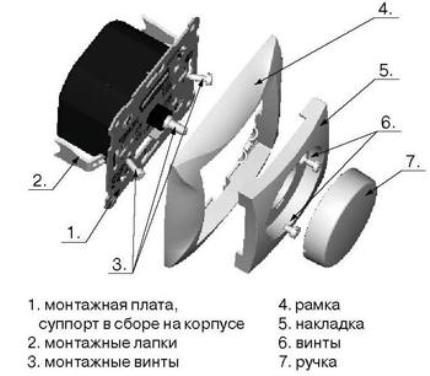
Resistor dimmers convert light energy into heat, so their use practically does not reduce the cost of electricity.
Triac based dimmers
A more modern option are devices made on the basis of a triac (triac) - a semiconductor device.
The principle of operation of such devices is as follows. To turn on the lamp, it is necessary that a current passes through the triac, that is, you need to create a certain voltage between the electrodes. Achieve this by recharging the capacitor from the potentiometer R, while the latter will change the phase angle.
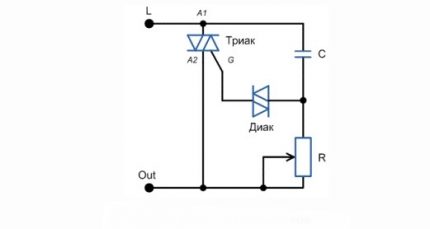
As soon as the voltage indicator on the capacitor reaches a certain value, the triac will open, so that an electric current can pass through it. At the same time, the resistance of the device decreases, because of which the bulb will burn more strongly. A similar process is observed with both positive and negative half-waves. This is due to the symmetry of the diac and triac, for which it does not matter in which direction the electron flow flows.
The voltage at the active load is an alternation of positive and negative half-waves, which follow alternately with a frequency of 100 Hz. Due to the extremely short sections at low voltage, flickering can occur, which the rheostat dimmers are deprived of, as well as dimmers equipped with frequency converters.
Design features of dimmers
According to the design features, several types of devices can be distinguished, the most common of which are modular, monoblock and boxed.
Modular dimmers
Switchboards of this type are usually equipped with switchboards. Such devices are perfectly combined with incandescent and halogen devicesequipped with step-down transformers.
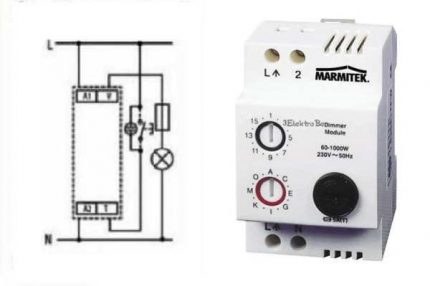
Such devices are controlled using a key or a button. Quickly clicking on them, the user turns on or off the lamp, and holding his finger for five or more seconds. gets the opportunity to use the light control mode.
Mounting box dimmers
These dimmers are mounted in boxes that are used for switches and sockets.Devices can be combined with incandescent lamps and halogen devices, regardless of whether they are equipped with electronic or step-down transformers, giving a capacitive or inductive load.
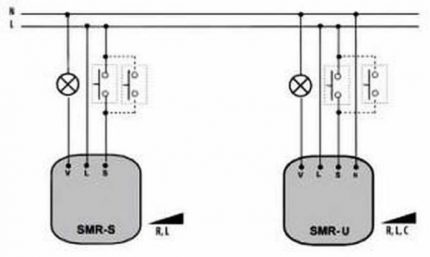
To control dimmers of this type, a button is enough that is mounted on top of the installed device. Installation of the device is carried out similarly to a traditional switch with strict polarity.
More details on how to choose a dimmer for incandescent lamps can be found in this stuff.
Monoblock devices and their types
Such devices are an integral unit that is installed in a junction box similar to a traditional switch. To install such a device, you first need to take care of the installation socket, the size of which depends on the parameters of the dimmer (the size range starts from 26 mm).
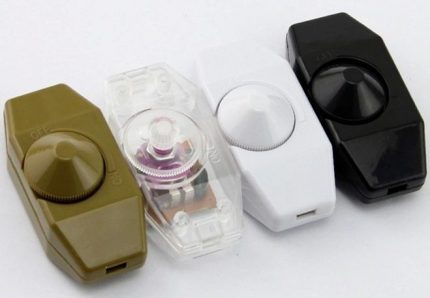
Dimmers of this type are especially recommended for installation in thin partitions, where due to the insufficient thickness of the walls it is difficult to place conventional devices. The difference between monoblocks from the previous category of devices is a two-wire connection, which is why it is included in the breaking of the load phase circuit.
In turn, considering the method of regulating monoblock devices, several varieties can also be distinguished:
- push and turn;
- keyboards;
- rotary;
- sensory;
- remote.
These options are presented below.
The inclusion of push-and-rotate devices is carried out by pressing the handle of the key, while its rotation allows you to adjust the light level.
Dimmer and Lamp Compatibility
When choosing dimmers it is necessary to pay attention to the types of lighting devices for which they are intended.
For incandescent, as well as halogen lamps, designed for standard voltage, almost any device is suitable. It is only important to remember that when the voltage decreases, the color of the light flux will change. At low voltage, it has a reddish tint, which is not only unpleasant, but also harmful to the eyes.
To control low voltage halogen devices (12-24 V), devices compatible with step-down transformers (RL) are suitable. If an electronic transformer is supposed, it is recommended to give preference to the dimmer model, marked with C.
Regulating devices for low-voltage light sources, as a rule, are equipped with mechanisms for smooth on / off.It is important to keep in mind that such devices are especially sensitive to voltage drops, which can lead to a significant period of reduction in the operational period.
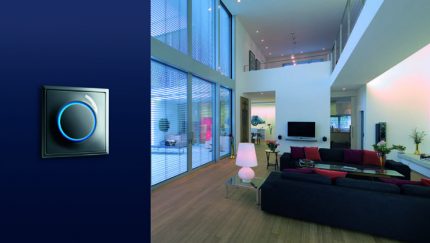
Dimmers for high voltage circuits are most often used to control the brightness level of theater halls. Since there is significant energy consumption in this case, it is important to make sure that the selected dimmer model is designed for significant loads.
The design of switches with regulators designed for fluorescent light sources provides a special starting device for converting the supply frequency in the range of 20-59 kHz. This allows you to change the value of the current passing through the circuit, which allows you to influence the brightness level of the lamps.
The functioning of dimmers used for LED lamps is based on the method of pulse-width modulation. The degree of power of the light flux is adjusted by changing the duration of the current pulses, which are fed to the LEDs with optimally calibrated amplitude. Due to the high frequency of the supplied pulses, reaching 0.3 MHz, the flickering of lamps is excluded, which adversely affects vision.
To learn about the features of dimmers and their compatibility with various lighting devices allow markings that are applied to such devices:
- The Latin letter R, applied to the dimmer, indicates that it can be used to adjust the light in incandescent lamps having an "Ohm" or "Resistive" load.
- The letter L allows operation with transformers that reduce voltage and inductive load.
- The Latin letter C indicates that the device can be combined with electronic transformers ("Capacitive" load).
A special icon, indicating the approval of lighting control, is also placed on fluorescent and energy-saving lamps.
Advantages and disadvantages of dimmers
The advantages of various types of switches with regulators include a smooth start-up of the lighting system, which can significantly increase the service life of lighting devices (the operation period for incandescent lamps in this case increases up to 40%).
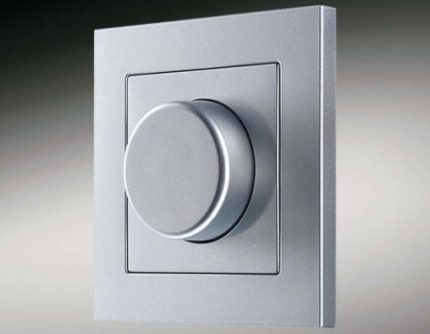
Such devices create unlimited possibilities for interior decoration. With their help, it is easy to carry out spot illumination of the selected zone, to create interesting light paintings. A valuable feature of dimmers is also the ability to control light sources remotely or through sounds.
However, such devices also have their drawbacks. Dimmers can only be used to control light sources whose power corresponds to a similar indicator of the device. Due to the nature of the output voltage, step-down transformers may not work correctly.
Devices can cause electromagnetic interference, which will interfere with the operation of the radio and other devices. Certain types of lamps (especially those equipped with additional devices - electronic ballasts, drivers) cannot, in principle, be combined with dimmers. The efficiency of dimmers when working with incandescent lamps is quite low. Lowering the brightness of the lamps has little effect on the consumption of electricity, which instead of light turns into heat.
Three basic wiring diagrams
Dimmers are integrated in the open circuit of the power supply, which allows these devices to regulate the voltage supplied to the lighting devices. In this case, several mounting schemes are possible.
A typical option, which is especially recommended for connecting resistive and sensory devices, is a device controlled from one place.
In bedrooms, adjustment from two places is often used. In this case, one device is mounted at the bed, the other is connected at the entrance, which allows you to change the brightness of the lighting while lying in bed.
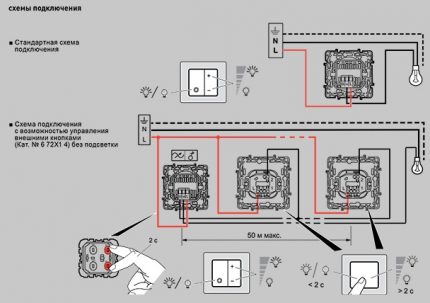
The universal scheme involves regulation from one place, and management from two. With this option, a switch is installed at the input, while control devices are located in two different areas of the room.
In spacious rooms (especially the elongated shape), it is recommended to apply a scheme in which adjustment is also made from one place, and control from three. In this case, it is advisable to use pass-through dimmers that allow you to turn on the lamp in a certain area of the room, while turning off the lighting in other areas.
Consider a number of the most popular options for connecting dimmers: directly to the switch, built-in type and with a remote button.
The dimmer is connected to the switch
To perform installation, you must turn off the electric current. After making sure that it does not fall on the terminals of the device, you need to remove the switch. First of all, the lid of the device (one- or two-key panel) that covers the connecting elements is removed.
Then, the fastening screws are loosened with a screwdriver, after which the structure is carefully removed from the wall. In this case, it is necessary to monitor the integrity of the insulation coating of the wires. If it is accidentally broken, you need to immediately tape the damage with insulation tape. The final step is to disconnect the wires from the terminals.
After that, you can do the installation of a dimmer. Wires are connected to the terminals of the device, then the fasteners are checked for strength. It should be noted that the section of the wire protruding beyond the terminal must be exposed no more than 0.3 cm. The excess end can be cut off or insulated.
Without damaging the insulation of the wires, place the dimmer in the place where the switch was located. The device is pressed against the wall and fixed with screws. All other parts of the structure are also connected to the dimmer.
After completion of work, you need to turn on the supply of electric current and try the process of adjusting the light to check the correct operation of the device.
Switch connection with integrated dimmer
On sale, you can often find switches whose design involves a built-in element that controls the brightness of the light. Their installation does not differ from the installation of a conventional device.
A switch is inserted into a hole specially made in the wall, from which the top cover is previously removed. The design is connected to the wiring and fixed with bolts. As in the previous case, it is necessary to control the quality of work: after turning on the electricity, the device should allow to dim the lighting.
Connecting a device with a remote button
It is very convenient for a bedroom to connect a dimmer at the same time as a simple switch, while a dimmer is installed near the bed to adjust the level of lighting directly from the bed.
The kit of such a device includes additional control buttons, which can be installed at a distance of up to 50 meters from the regulator.

To install the device, the phase wire is connected to the regulator terminal No. 1 and the first terminals of the remote buttons. From the second terminals of the remote buttons, the wire is thrown to terminal B of the controller. The load is connected to the terminal No. 2 of the dimmer and the neutral wire N.
We also recommend that you read the step-by-step instructions for connecting a dimmer. More details - go to the link.
Leading dimmer manufacturers
Switches with the function of regulating light are included in the catalogs of many companies specializing in the manufacture of electrical equipment. We will name only a few of them.
Schneider electric (France). Power engineering company, founded in 1836. Branded dimmers (Unica, Merten) are distinguished by good build quality and spectacular design (streamlined shape, wide color gamut), due to which they serve as an interior decoration.
Teco. The Czech company Teco began operations in 1919, having established the production of equipment for telegraphs and telephony. Currently, it is a leading global manufacturer of sensors, touch buttons and similar devices. A large place in the catalog is given to dimmers, which impress with a combination of excellent performance and affordable cost.
Jung. A family-owned German company with more than a century of history offers a wide range of electrical products and specialized equipment, including dimmers. All products of the enterprise are characterized by high technical parameters, functionality, excellent build quality and components used, as well as a well-designed design.
Legrand. The French company, established in 1886, is currently the leader in the production of electrical equipment. The company's products are used for domestic and industrial purposes; office buildings are also equipped with it.
The company pays great attention to the development of innovative technologies, conducting its own research. The company manufactures high-tech models of dimmers that fit perfectly into the system "Smart House".
Gira (Germany). Established in 1905, a German company currently has representative offices in 37 countries of the world, including Russia. The company is characterized by a quick response to customer requests.
To achieve this, the tireless monitoring of the core market, as well as the existing production and scientific base, helps.Dimmers produced by the company are characterized by a universal classic design and impeccable quality, which guarantees long-term use.
In addition, high-quality models of other brands are presented on the market, for example, the German concern Simens or the Polish company Godiva.
Conclusions and useful video on the topic
In the video you can hear the opinion of a specialist about the most popular models of switches with different types of dimmers, as well as connection tips:
How to install a keyboard dimmer with your own hands:
On the interaction of dimmers and lamps:
The dimmer, with which you can change the brightness level of lighting, is a comfortable device that allows you to create a cozy atmosphere in the room and reduce energy consumption. The presented assortment of such products is quite wide. In order not to make a mistake in the choice, you need to take into account the power of the lamps with which it will be combined, the design features of the device, its planned location, as well as the appearance of the device.
Do you have interesting information on the topic of an article that you can share with our readers? Please leave your comments, share experiences, ask questions in the block below.

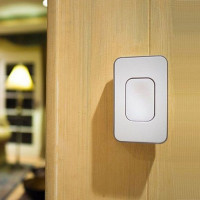 Wireless light switch: selection criteria + review of the best models
Wireless light switch: selection criteria + review of the best models 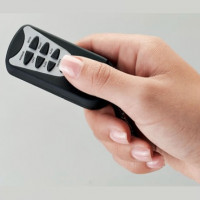 Light switch with remote control: types + overview of TOP brands
Light switch with remote control: types + overview of TOP brands 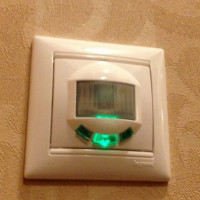 Switch with motion sensor: how to choose and install a light switch with a sensor
Switch with motion sensor: how to choose and install a light switch with a sensor 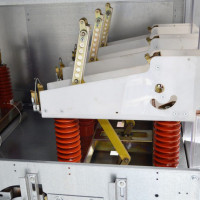 Load breaker: purpose, device, features of selection and installation
Load breaker: purpose, device, features of selection and installation 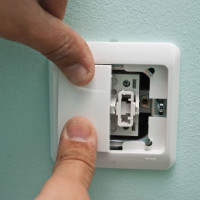 How to disassemble a light switch for repair or replacement
How to disassemble a light switch for repair or replacement 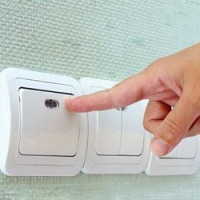 How to install a light switch: step-by-step instructions for connecting typical switches
How to install a light switch: step-by-step instructions for connecting typical switches  How much does it cost to connect gas to a private house: the price of organizing gas supply
How much does it cost to connect gas to a private house: the price of organizing gas supply  The best washing machines with dryer: model rating and customer tips
The best washing machines with dryer: model rating and customer tips  What is the color temperature of light and the nuances of choosing the temperature of the lamps to suit your needs
What is the color temperature of light and the nuances of choosing the temperature of the lamps to suit your needs  Replacement of a geyser in an apartment: replacement paperwork + basic norms and requirements
Replacement of a geyser in an apartment: replacement paperwork + basic norms and requirements
Of course, one can live without such a regulator, but it is much more convenient with him. No need to install many lamps and fixtures, several chandeliers, as well as switches throughout the house or apartment. All brightness can be adjusted with one small device. Moreover, they have a very nice design, without any problems you can fit into any interior. For me, this is a good addition to comfortable living.
I don’t quite understand, Natalia, this part of your review - “You don’t have to install a lot of lamps and fixtures ... the brightness can be adjusted with a small device.”
Let me explain: a dimmer is mounted in a circuit of a specific light source - I mean a chandelier, a lamp, a lamp, etc. All home lighting is not regulated by him. Of course, there are multichannel regulators, but this is a completely different story.
A dimmer, it’s also a dimmer of a light bulb, is a very convenient thing. Installed this in the nursery, because sometimes the child is afraid to sleep alone in the dark, so we leave a weak light. It is also useful when you need to pick up some thing, but he is already sleeping. The dimmer was set by Turkish, it seems, Mackel or something like that. There were no problems with the installation, there is nothing complicated in its installation.